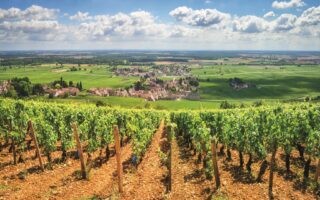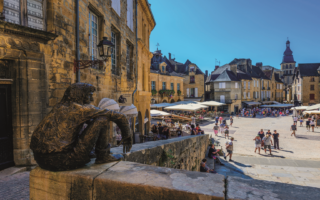Corrèze, the Millau Viaduct and the Seaside
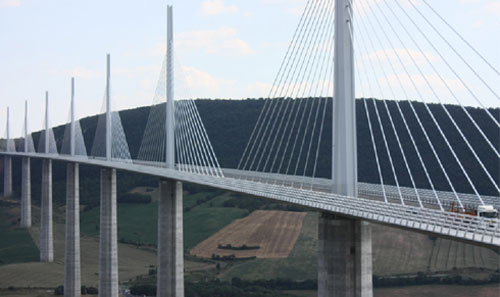

You are probably fed up with me always telling you how wonderful the French people are, and how amazing the architecture is and how stunningly beautiful are the hamlets and villages of rural France. Well be prepared for another self indulgent essay about a country that both my wife and I have fallen in love with, but this episode is slightly different and has a uniquely British slant about it, and to be more precise it has a lot to do with the north east of England, where I live.
The north east of England connection, has to do with lord Norman Forster and his collaboration with Michel Virlogeux and the building of the worlds tallest bridge at Millau. Michel Virlogeux had the vision to span the gorge at Millau but needed the design genius if of lord Forster to make it happen.
It has long been a desire within me to visit this bridge after seeing so many documentaries about it, and of course to see at first hand how local to me, architect Norman Forster had handled the unique challenge presented by the high altitude and mountainous area of the Aveyron.
So during our present visit to the Creuse in the Limousin, and on a particularly warm and sunny day we decided to check out how far it was to Millau and make the long drive to see the viaduct that is a miracle of modern spanning the gorge and the river Tarn.
The sat nav, which in my experience always lies, said five hours driving, hmm I thought, even allowing for coffee breaks and photographic stops, if I set off at 7 – 7: 30am I still could be there for one-ish and in time for lunch. That night I pawed over large relief map of France, tracing my ideal route for the most picturesque and for the speediest arrival to our destination.
During the night we moved the goal posts, and we had now decided to make it a two day trip and after the visit to the viaduct we were going to have lunch and then travel southwards towards the Mediterranean and stay in the town of Bezier for the night. Bezier was an old town and a only a further two hours drive down the motorway, and just ten miles from the seaside, giving us time for a romantic evening stroll along the beach, a fitting end to a perfect day.
So the next day dawned and after a nice cup of Yorkshire tea followed by a fresh strong coffee, and very lazy start to the day, we eventually departed at roughly 8am, heading southward on a mini holiday within a holiday.

One hundred yards later, the sat nav and I were at odds, it wanted to turn right as I left the village but I needed to go left to fill up with petrol, guess what, I won. Sixty euros of sans plomb 95 Later (unleaded petrol) I took the road from the petrol station at Bourganeuf to Peyrat le chateau, then on to Eymoutiers, then through to the ancient city of Tulle famous for it’s long history of lace making. The sun shone brighter and hotter as we left the Creuse behind, then we crossed over through the Haute Vienne, and then into the beautiful and dynamic Correze.
The landscape changed almost immediately, from the rolling hills and pastures to a much hillier terrain, but if possible even more beautiful than our own wonderful Creuse. Still travelling south east but losing time rapidly because of the many a photo opportunity stops, we came at last into the hill town of Correze itself, and decide to treat ourselves to a break, and a good look around. The sun was just coming up to its zenith, and showed no signs of abating, the buildings reflected back the suns light and the shadows cast were strong and sharp edged.
A visit to the air conditioned tourist information was a blessed relief from the noon day sun, two young girls who spoke excellent English, pointed me in the right direction to the best cup of Correze coffee, and handed me some very useless guide pamphlets. They were right, the hotel coffee was excellent, so refreshed and cooled, it was time to climb aboard our mobile oven and continue onto Millau.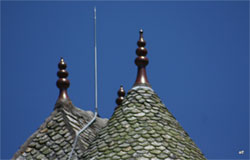 It was by now apparently obvious that lunch by the Millau Viaduct, was a thing of the past, we’d be lucky to make it for tea time at our rate of travel, apart from the photographic stops the roads were narrow andmountainous with many a hairpin bends. By now we were in the department of Lot and another transformation had taken place with all the roofs taking on a different look, with the orange roof tiles being replaced with jet black tiles of stone and all with hand carved rough semi circular ends, The effect was absolutely stunning, every was roof we passed showed unique black rows of thick petal like tiles, it must have taken ages to shape and fit them. Not only the roofs took on a different persona, but also did the houses, with a huge increase in the amount of round towers all beautifully finished of with the cone shaped tops with the same tiles, adding a fairytale castle look.
It was by now apparently obvious that lunch by the Millau Viaduct, was a thing of the past, we’d be lucky to make it for tea time at our rate of travel, apart from the photographic stops the roads were narrow andmountainous with many a hairpin bends. By now we were in the department of Lot and another transformation had taken place with all the roofs taking on a different look, with the orange roof tiles being replaced with jet black tiles of stone and all with hand carved rough semi circular ends, The effect was absolutely stunning, every was roof we passed showed unique black rows of thick petal like tiles, it must have taken ages to shape and fit them. Not only the roofs took on a different persona, but also did the houses, with a huge increase in the amount of round towers all beautifully finished of with the cone shaped tops with the same tiles, adding a fairytale castle look.
The valley road followed a wide river and twisted and turned and climbed gently but steadily upwards for several miles. Progress was painfully slow, as the little traffic that we encountered was either farm vehicles or sightseers, and no one was in a hurry to get anywhere fast, especially me. Finally reaching the pass over the mountains the road turned into a wide three laned highway, the traffic disappeared and the descent was a rapid three kilometre drop to the valley below.
At this point, I had ran out of adjectives to describe what we were looking at, beautiful, fantastic, stupendous, did not do justice to the amazing wild and rugged views that stunned us into silence. The hair pin bends demanded concentration, as did the tunnels cut through the living rock, one minute plunging you into a twilight surreal world of electric lighting, and the next minute exploding you into the dazzling bright sun shining from a sky of azure blue. The most frustrating part of the descent was the tantalising glimpses of the hillside villages, cathedral tops, and medieval river bridges that were shown to us through the thick oak and chestnut forests, frustrating in the sense, there were no lay-by’s where you could stop and enjoy the panoramic views. Finally the road reached the valley floor, flattened out and led us quickly one of the quaint villages that we had espied on our descent.
This was the Lot gorge and was as narrow as it very high, with its sides being covered in deciduous forests leaving only a ribbon of blue cloudless sky above us. An equally ancient and single track stone bridge with wide sweeping arches that were reflected in the still waters, spanned the wide lazy river, It was now time to stop and look at natures breath taking and wondrous valley, the air was hot and still, the only sounds were the water occasionally breaking over stones, and the deep hum of the busy insects.

It was about one thirty and the car park had a few people of varying nationalities all indulging in lunch, and lounging lazily in the hot sun, so we joined them for a fifteen minute break, as much as for the car’s benefit as for ourselves. Time to check the map grab bite to eat (picnic style) and estimate our arrival time at the bridge and calculate our arrival at the Etape hotel in Bezier, the times were way out and not looking good. Never mind, we were on holiday and the hotel had been booked on line, and would be there waiting for us. Suitably refreshed we once more headed down the Lot Gorge, twisted and winding along picturesque roads, this time with the river on our right and sheer cliff faces on our left, and intermitting road signs bearing ominous pictures of falling boulders.
The road did occasionally cross the river over yet another old stone bridge, only to zig zag back across a mile or two later on, and ever present were the warning signs of falling rocks, and huge stretches of wire mesh netting, affording the traveller some protection from the minor falling stones. Our journey soon took us from valley floor and as ever followed a winding course of least resistance and as it did so the landscape changed from the steep sided rocky gorge to one of hill tops and plateaus. The mountain villages slipped behind us as did the river and being replaced with farm houses and the odd hamlet, all bathed in beautiful sunshine, and coloured by the wonderful summer flowers of dazzling yellows and the reds of the poppies.
 After about an hour of travelling the first road signs for the Millau Bridge appeared, and soon after that, through the misty haze of distance, the silver sheen of the seven distinct towers of the bridge could be seen. Thirty minutes later we arrived at the Aire De Millau, a rest area specially built for motorists to stop and admire the bridge. The brand new rest area, provided toilets, restaurant, souvenir shops, and a small cinema where a continuous documentary ran for those that wanted to see how this beautiful bridge was constructed.
After about an hour of travelling the first road signs for the Millau Bridge appeared, and soon after that, through the misty haze of distance, the silver sheen of the seven distinct towers of the bridge could be seen. Thirty minutes later we arrived at the Aire De Millau, a rest area specially built for motorists to stop and admire the bridge. The brand new rest area, provided toilets, restaurant, souvenir shops, and a small cinema where a continuous documentary ran for those that wanted to see how this beautiful bridge was constructed.
I of course wanted to see the edifice for myself, so after an ice cold beer, Catherine and I walked to bottom of the car park, where a small viewing platform gave a perfect view of the village of Millau nestling cosily on the valley floor a thousand feet below us, and to our immediate right their stood the bridge towering above us. The camera clicked and the video whirred and captured for an eternity the magnificent work of art created by Lord Forster. There is better vantage point to view the bridge, but that involved a steep climb of a few hundred feet, away from the car park, so off I went, alone this time, and in the searing afternoon heat I scaled the hill that brought me level with the top of the 7 suspension pylons. And wow, what a view, I looked down upon the road way of the mile long viaduct, counted the seven pylons which held the road deck in place and watched the tiny cars crawl their way across from one side to the other. My curiosity now being satisfied and the time was getting on, so I gingerly made the steep descent back down to the car park passing other on their way down and others excitedly making their way up to the viewing platform.
Back at the car I read the free brochure and gleaned these facts about the bridge. It is a n incredible 2,460 metres long, and only touches the ground at nine points, the seven support piers used 85,000 square metres of concrete in their construction, the road deck is made from thermo mechanical steel and weighs in at 36,000 tons which is 5 times heavier than the Eiffel tower, and cost was around four hundred million euros to construct. Importantly the motorway now provides a fast and economic route from Paris to the south coast, and with that in mind we now drove over the bridge and headed towards our Mediterranean destination of Bezier. Impressed as I was with the bridge and its dynamic looks, I felt a little disappointed at not being to see down into the valley, but that was probably a deliberate safety decision on the designer’s part, to stop potential accidents as drivers peered down to the valley way below them.
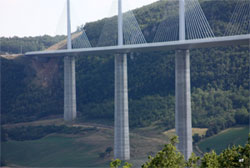 The motorway had one more surprise for us, and that was another huge wow from my point of view, we were almost sitting metaphorically on top the motorway world, with the bridge being the epoch. The last surprise came upon us suddenly as we left a long toad tunnel cut directly through the mountain and the surprise was the descent to the valley floor. The road literally plummeted downwards with the six lane ribbon of black tar sweeping majestically down in huge gentle curves, the scenery was dazzling, with deep forested mountain sides on our right, and a living wall of white rock to right towering hundreds of feet above us.
The motorway had one more surprise for us, and that was another huge wow from my point of view, we were almost sitting metaphorically on top the motorway world, with the bridge being the epoch. The last surprise came upon us suddenly as we left a long toad tunnel cut directly through the mountain and the surprise was the descent to the valley floor. The road literally plummeted downwards with the six lane ribbon of black tar sweeping majestically down in huge gentle curves, the scenery was dazzling, with deep forested mountain sides on our right, and a living wall of white rock to right towering hundreds of feet above us.
The downward speeds were an exhilarating sixty to seventy miles per hour, with short straight stretches and many graceful curves closely hugging the cliff side and equally sheer drop on my right, it was natures own roller coaster ride. After what seemed a lifetime descending through the breathtaking scenery we finally arrived at the valleys bottom and headed in a straight line for our hotel in Bezier. The next hour was spent driving along and looking at flat open scrub land which in all honesty came a very poor second to the previous 4 hours of gorges, mountains majestic valley’s, and hill top citadels.
After booking into the hotel at around 7pm we showered the hot dusty day from our minds and body and sadistically punished ourselves with a nine mile drive to the seaside. I thought the day’s surprises were over, but France held one more for us. The Mediterranean is and always will be a magnet to people; its very name is evocative and conjures up a wealth of ideas and thoughts about sun, sea, and sand. It was a small town, built upon a grid system, without a single free parking bay, I’ve never seen so many people packed into one place before, the only parking spaces available was when someone left. Ten minutes of driving secured us a place, but it was 9:30 pm and with the promenade shoulder to shoulder with people, every restaurant, and believe me there were many, full to bursting point, we decided to soak up the atmosphere and then have an early night.
 The harbour was crowded with yachts of all shapes and sizes, and all with wonderful mirror images reflecting upon the still sea water’s surface, the restaurants were emblazoned with coloured lights and music hung upon the air from a French singer and band performing in the open air amphitheatre. The fairground hustled and bustled with young people and carnival music added to the excitement that electrified the seaside air, and everywhere cars looked for parking and had to give way to the people riding four wheeled bicycles.
The harbour was crowded with yachts of all shapes and sizes, and all with wonderful mirror images reflecting upon the still sea water’s surface, the restaurants were emblazoned with coloured lights and music hung upon the air from a French singer and band performing in the open air amphitheatre. The fairground hustled and bustled with young people and carnival music added to the excitement that electrified the seaside air, and everywhere cars looked for parking and had to give way to the people riding four wheeled bicycles.
Typical of many a seaside town, the restaurants and souvenir shops crowded the seafront, almost tumbling over the narrow one way road, with a small wall stopping them from invading the golden sands and the sea itself. Night now fell, it was dark, warm and electric with life, but as we were hugging the coast tomorrow, on our way to Carcassonne, the sea ad sand would have to wait, we decided to call it a night and drove back to the hotel, freeing up one more parking space for the revellers of the night.
Terry Ferdinand
Article kindly provided by
Terry Ferdinand
Catch Terry on on of his regular radio slots on www.bishopfm.com
THE FOLK SHOW 9 – 11pm MONDAY
LUNCH WITH TERRY 12 -2pm every SATURDAY
THE CLASSICAL HOUR 4 – 5pm every SUNDAY
Or join him on FACEBOOK
All photos supplied by and copyright of
T Ferdinand
Share to: Facebook Twitter LinkedIn Email
More in aveyron, beach, guides, maps, renovation, summer, travel
By FrenchEntrée
Leave a reply
Your email address will not be published. Required fields are marked *

